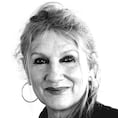For me, the highlight of Laurie Anderson’s recent solo work The Art of Falling, which she brought to Dublin’s National Concert Hall in April, accompanied by cellist Rubin Kodheli, was when she danced with the ghost of her deceased husband, Lou Reed.
The diminutive Anderson came centre-stage to explain to a packed auditorium that Reed, apart from being a musician, singer, songwriter and poet, had also been a tai chi master. Preparing herself to demonstrate a series of stances, the septuagenarian performer told us (and I’m paraphrasing here) that the discipline – which has been central to Chinese martial arts culture for centuries – is practised both as self-defence training and for its health benefits.
At one stage, she asked the audience to close their eyes while she brought us inwards to a central point of consciousness
To become a master of this graceful, powerful combination of dance and combat, the tai chi student must learn to focus and calm the mind in order to release stress, and, crucially, train the body to yield.
I watched Anderson, in her runners and baggy trousers, her white shirt and boxy black jacket, progress through a series of moves, while behind her a screen flashed with their names: Part the Wild Horse’s Mane, Grasp the Peacock’s Tail, Cloud Hands.
The day of her mother’s funeral, the 10-year-old was taken for a jaunt in a private plane
Hilary Fannin: My pals and I didn’t understand the stern forces that extinguished our youth
She had a T-shirt that said ‘Cute but Psycho’. I doubt she was the latter
Hilary Fannin: Francis Bacon offers a kind of therapy away from London opulence
As she proceeded, alone in the pinkish light, she managed to impart a sense that the gestures, and their repetition, could in some way evoke the man with whom, she said, she had shared a constant conversation. Her dance, then, was not without a partner; the routine, an echo of intimacy, seemed almost to become a physicalisation of his memory.
“He died on Sunday morning, looking at the trees and doing the famous 21 form of tai chi with just his musician hands moving through the air,” she said after his death in 2013.
The Art of Falling, Anderson’s response to some of the complex questions thrown out by our shifting contemporary world, was billed as a mix of stories about falling in love, falling asleep and falling in line. It can’t have been easy to distil her performance, built on instinct and improvisation, into such a neat soundbite.
At one stage, she asked the audience to close their eyes while she brought us inwards to a central point of consciousness, a place of awareness and maybe even acceptance.
I liked her presence and there was a part of me that wanted to do as she suggested, to allow her voice carry me toward that internal destination. I struggled though: fearing congregations, I let my lifelong instinct not to do what I’m told win, and instead glanced at the stranger beside me. I saw his eyes close and the musculature of his face relax, while his body briefly seemed to settle into some other kind of element. I almost envied him.
My pal had been sitting a few rows away, as we’d not managed to get seats side by side. Afterwards, she and I walked along the side of St Stephen’s Green, where young women in nude high heels spoke frantically into their mobiles and well-toned boys in peacock-blue suits strutted towards Grafton Street, elbows akimbo. Back in the real world, if that’s what it was, I felt sad to have missed my opportunity to yield to Anderson’s art.
“I submitted entirely,” said my pal, who had indeed left the concert hall in a state that we used to call grace.
“You resist the unfamiliar,” she added. “But, for me, everything is unfamiliar now and I feel everything with intensity.”
Earlier, as we walked in the bright spring evening to the venue, she told me that in the months since her husband’s death, in April of last year, she has walked hundreds and hundreds and hundreds of kilometres, sometimes in a group, sometimes alone, sometimes in Ireland near her rural home, sometimes abroad through dry terrain.
“I’m learning to carry my grief ,” she said.
For all the huge distance she has covered on foot, and despite the meditative nature of those journeys, through sandstorms and rainstorms, she has, she said, moved just inches towards the centre of the bed she used to share with him.
We parted near Camden Street. I walked on alone, the yellowy blue sky still lighting up the city.
I wondered if the achievement of Anderson, who was the first official artist in residence at the US space agency Nasa, might be in making us feel that we are not solely bound to the here and now, that there are other dimensions to explore, other ways of experiencing and understanding.
I think I just need to go there with my eyes still open.















